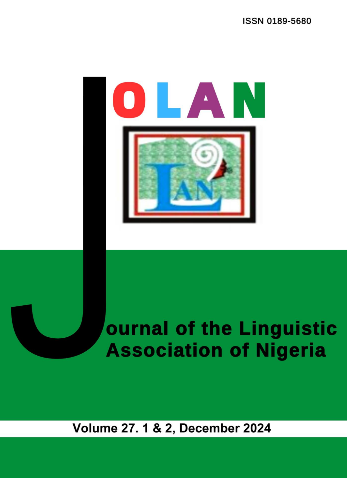A Sociolinguistic analysis of landscape in the University of Ibadan
Keywords:
Linguistic landscape, sign producers, sign consumers, emplacement, contextAbstract
This study of human communication has witnessed several approaches and it is recently witnessing the emergence of sociolinguistic landscape. Sign posts constitute the data for this study. Fifteen (15) signage were selected for analysis. The signposts were randomly selected across different places in the University of Ibadan community. These sign posts, which were of written and pictorial media, included both mobile and stationary signs. The study adopted Dell Hymes’ Ethnography of Communication for the data analysis. Specifically, the data were analysed within the context of the SPEAKING grid. It is revealed in the study that social variables
such as occupation, age group and gender are predominantly factors that influence sociolinguistic landscape.
Beyond this, purpose of the sign also influences the emplacement of sign posts, especially in terms of key and instrumentalities. Given the fact that all the signs reflect the English language, this study claims that the
sociolinguistic landscape does not only reflect the reality of the language use but also manifests the probable sociolinguistic variables that influence the intention of the sign-producers and the consumption of the signs by
the sign-consumers. In the emplacement of signs, social (sub) groups are created. This reveals that social stratification is not only reflected in verbal means of communication; it is transferred into written medium and visual media.
References
Adetunji, A. 2013. A sociolinguistic study of meaning-making in a Nigerian linguistic landscape: the example of Ibàdàn. Ph.D. Thesis. Office of Graduate Studies, Texas A&M University-Commerce. iv + 182pp.
_________. 2015. English in a Nigerian linguistic landscape. World Englishes 2015. 644-668
Akindele, F. and Adegbite, W. 2005. The sociology and politics of English in Nigeria: an introduction.Ile-Ife: O.A.U.Presss.
Backhaus, P. 2006. Multilingualism in Tokyo: a look into the linguistic landscape. International journal of multilingualism. 3(1): 52-66
Backhaus, P. 2007. Linguistic landscapes. A comparative study of urban multilingualism inTokyo. Clevedon, Buffalo, Toronto: Multilingual Matters.
Bobda, S. A. (2007). English in the sub-saharan linguistic landscape: Beginning of millennium observations. Anglia, 19(4), 579-595.
Bolton, K. 2012. World Englishes and linguistic landscapes. World Englishes, 31(1), 30-33.
Coulthard, M. 1977 An Introduction to Discourse Analysis London: Longman
De Klerk, G. and Wiley, T. G. 2010. Linguistic landscape as multi-layered representation: suburban Asian communities in the valley of the sun. E.Shohamy, E. Ben-Rafael and M. Barni. Eds.Linguistic Landscape in the Citypp. 307-
Bristol, Buffalo, Toronto: Multilingual Matters.
Finzel, A. M. 2012. English in the linguistic landscape of Hong Kong: a case study of shop signs and linguistic competence. Institutional Repository of the University of Potsdam: Germany
Gorter, D. 2006a. Introduction: The study of the Linguistic Landscape as a New Approach to Multilingualism. Linguistic Landscape: A New Approach to Multilingualism.E. Shohamy and D. Gorter. Eds. Clevedon, Buffalo, Toronto:
Multilingual Matters. 1-6.
Helot, C and Barni, M. 2012. Linguistic landscapes, multilingualism and social change. Peterlang: International Verlag der Wissenschaften
Hymes, D. 1972. Models of the interaction of language and social life. Directions in sociolinguistic: the ethnography of communication. J. Gumperz and D. Hymes. Eds. New York: Holt, Reinhart and Winston. 35-71
Kallen, J. L. 2011. Changing landscapes: Language, space and policy in the Dublin linguistic landscape. Semiotic landscapes: Language, image, space. A. Jaworski& C. Thurlow Eds. London/New York: Continuum. 41-58
Landry, R and Bourhis, R. 1997. Linguistic landscapes and ethnolinguistic vitality: An empirical study. Journal of language and social psychology 16: 23-4
Reh, M. 2004. Multilingual writing: A reader-oriented typology with examination from Lira Municipality, (Uganda). International Journal of the Sociology of Language 170: 1-41pp.
Pavlenko, A. 2010. Linguistic landscape of Kyiv, Ukraine: A diachronic study. Linguistic landscape in the city. E Shohamy, E. Ben-Rafael,& M. Barni. Eds. Bristol: Multilingual Matters. 133-152
Shohamy, E. and Waksman, S. 2009. Linguistic landscape as an ecological arena. Linguistic landscape in the city. E. Shohamy, E. Ben-Rafael, & M. Barni. Eds. Bristol: Multilingual Matters. 313-331
Shohamy, E. and Gorter,D. 2009.Linguistic landscape: Expanding the scenery. Oxford: Routledge.
Spolsky, B. and Cooper, R. L. 1991. The languages of Jerusalem. New York: Oxford University Press.
Spolsky, B. 2009. Prolegomena to a sociolinguistic theory of public signage.Linguistic Landscape: Expanding the sceneryE. Shohamyand D. Gorter. Eds. New York: Routledge. 25-39














